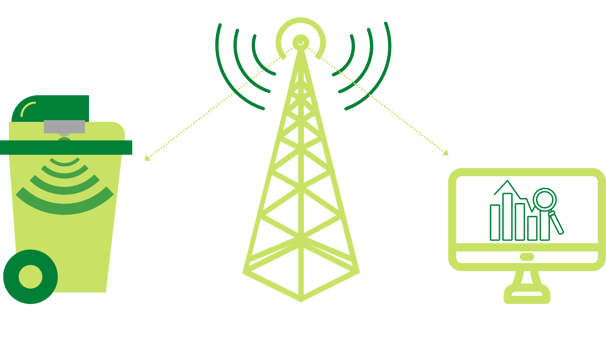EU strategy on textile collection and the latest technologies
How can wireless technologies and devices, support the textile waste management process? The "Bin Sensor" device and system.
According to the European Parliament's Bureau of Analysis, the European Union's textile strategy "should promote sustainability, circularity, traceability and transparency in the textile and clothing sector." An EU directive when it comes to textile fallout requires member states to establish separate textile collection systems by 2025 at the latest, it said, adding that the new Circular Economy Action Plan for 2020 identifies textiles as a key product value chain where urgent EU action is needed.
This will create a huge demand for access to containers where this type of waste can be stored. It seems that they will appear wherever there are currently containers for glass and paper. In large and small cities, in smaller and larger residential areas, etc.
As is well known, we live in a time of "fast fashion." Clothing and other textiles are relatively cheap and we have the opportunity to replace them frequently. This generates a huge amount of waste. Each inhabitant of a country belonging to the European Union consumes almost 15 kg of clothing and other textiles annually, according to an analysis by the European Environment Agency (EEA) in Copenhagen.
It seems that textile containers may fill up quickly, but on a much less regular basis compared to municipal waste containers. The question should be what can be done to make handling collection and disposal safe, efficient, low-impact and less expensive?
With help comes technology.
Textile waste in 2023-2025
Textile collection management with fill monitoring systems.
How do fill sensors work, what are the benefits of using a system to measure and monitor fill in containers and other waste bins? ICOBER's fill sensors are an excellent example.
It's easy to guess that the sensors placed in the containers must be battery-powered and able to communicate with the rest of the system, i.e. the platform, in such a way that they can be used anywhere regardless of access to utilities.
The latest communication technologies such as NarrowBand and LTE-M come to the rescue. These are networks that operate very similarly to those used by our "smartphone". However, they operate in a narrower band. The result is that communication using these technologies, is energy efficient. Which allows devices such as the fill sensor to operate for several years on battery power. The coverage of these networks is already 98% of our country.
With fill sensors, the user has the ability to monitor the fill level of an entire fleet of containers through a single platform, collect current and historical data, analyze this information for optimization, and plan, route and schedule exports. Managers, are notified of events such as high fill levels in a particular container or group of containers located in a particular region. The user is informed and notified of where and when a particular container has been emptied.
Fill sensors are equipped with a number of functions that are useful in the process of managing textile collection. Again, I will use ICOBER's fill sensors as an example. They have a built-in GPS module, which allow you to locate the sensors. This seems to be, a very useful feature for administrative purposes of collection companies and a kind of help in case of theft of containers, which is quite a common phenomenon.
A very interesting feature of this sensor is the built-in accelerometer. It allows it to detect the slightest movement or shaking of the container. Thanks to this, the manager of the container(s) is able to deduce whether the container may have been moved or for some reason be overturned.


The collection , disposal and broader management of textile waste can be challenging and generate huge costs for public institutions, for example. However, smart technologies can, make these processes easier and minimize the costs incurred.
Fill sensor system - summary
Optimization of textile export routes
Maintaining order
Safe collection with Bin Sensor
By being able to record container fill data over time, collection companies are able to minimize the frequency of collections and ensure that containers are emptied on time and people who want to use them do not find overflowing containers. This goes hand in hand with minimizing the costs that must be spent on the collection process. In an era of rising fuel prices, inflation and increasing costs, the use of smart technology can bring significant savings to the budget.
At many collection sites for all kinds of waste, it is common to see overflowing bins and a big mess around. The fullness sensors, and in fact the information they provide, are able to help in the decision-making process when it comes to waste disposal. Thanks to the data, waste collection companies and institutions that commission waste collection are able to work out a model that will ensure that collection is carried out frequently enough, but that there is no situation where "empty" containers are emptied. Therefore, there will be a kind of compromise between parties A and B, i.e. the client and the waste collection contractor.
Returning to the crux of the matter, i.e. technology and collection of textile waste, it is not hard to guess that this type of goods, can be a tasty morsel for thieves. Here again there is room for technology, which provides, for example, the aforementioned fill sensor.
Modules in the form of accelerometer and GPS, allow not only immediate recognition of whether the container has been hit in any way, but also tracking the location of such a container on the map. In addition, the user can be immediately notified of such an event in the form of a notification on the web platform as well as email or sms.










